I have completely fallen in love with Vintage Hair Styles. I like many current ones too, but I love the 1940s, 50s, 60s, 70s, and 80s. I guess I was born in the wrong era. I'd love to recreate them, but it's hard to do since the techniques were so different back then, and much of the information is lost. There are a few books, but they assume you are familiar with the techniques of the day, like pin curls and finger waves. We do things very differently today. Professionals communicated with each other and the public in periodicals, most of which have disappeared.
But a small group of people is trying to find and archive as much information as possible. They search for old hairstyling magazines, scan them, and make them available to the rest of us. Big shoutout to Pete, which is a boy name but belongs to a very nice cis-gender lady from Canada who has been incredibly helpful to me in this quest.
If you have never done a roller set, I highly recommend reading the first part of Creating the Marilyn Wig. That describes the process of putting on rollers, steam wigs, etc., which you will need to know if you want to try any of the roller sets in this article.
A Few Basic Roller Sets
Here are a few easy roller sets of the past that I like. I suggest taking these as starting points and experimenting with different roller angles, brush-outs, and patterns.
The idea of a roller set is that the hair will retain some of the shape given to it by the curlers. The roller setting pattern does affect the finished hairstyle, but it is not as much as you might think. For sure, it's not as much as I thought. Take heart if you are a beginner because this means even if you suck at roller sets and don't do an immaculate job of it, you can still end up with a nice or even a great result.
A Quick Review of Some Basics.
- Large curlers give volume but minimal curl.
- Small curlers give curls but minimal volume.
- Use on-base sets to maximize either curl or volume.
- Don't put too much hair on each roller: use the roller to set the base length and width.
- Use roller paper to keep the ends nice. If you can't use roller papers, tuck the ends of the hair underneath the hair on the roller, or the ends will look horrible!
- Don't be afraid to experiment.
Pattern Number 1.
This is probably the most common roller setting pattern and is straightforward. The pattern and finished photo is from the magazine Set'n Style from 1976. That was the most popular hair styling magazine of the 1970s:
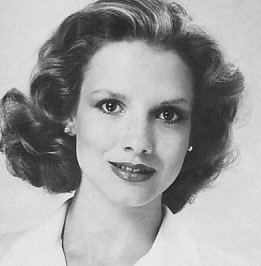
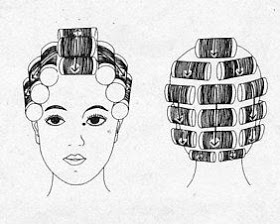
To set your hair this way, section out a roller-sized section of hair from your forehead and comb it back. Then take roller-sized sections next to it and comb them towards each ear. Start with a roller at your forehead and keep adding them, moving back along the center until you reach the back of your crown. You could also continue to the base of the neck. Set all rollers on base for maximum curl.
Now do the left and right sections and finish by filling the empty spaces in the back with curlers, as shown. Steam and let it sit until dry. Once it is dry, you can use it as a foundation for any hairdo with a lot of volume on top and a little flip on either side. To get the style in the photo, comb it back and slightly sideways.
VARIATIONS
Change the size of the rollers and the direction. For example, instead of going straight back along the center of the head, start over one eye and go diagonally across the head. You can get a more curly and tousled look by using smaller curlers but roll them in alternate directions. You can do lots of fun things with this simple but beautiful set.
Pattern Number 2, the "Halo"
They call this the "halo" because the front curlers form a halo around your face:
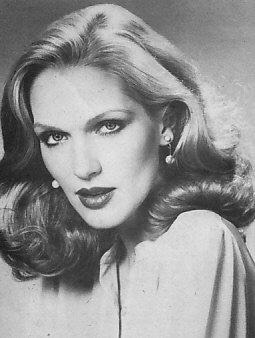
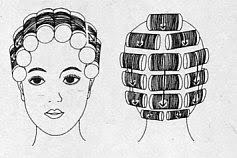
Choose the location for your part, then wind the curlers left and right towards your ears from where you want the part to be. Fill in the back with nice, tidy rows. This set lends itself to beautiful, gently flowing waves combed left and right (as you can see in the photograph). If you forget to wind the curlers left and right from the part, you will fight the hair when you try to comb it out. This is another article from Set'n Style, winter edition 1982.
Variations
One interesting variation is to set the back with vertical rollers instead of horizontal ones. This interesting modern variation on this style gives a long, flowing curve.
Pattern Number 3, The "Brick"
This is harder to do, and a word of warning: Depending on your wig, it might not even be possible. It depends partly on how much hair is in your wig and how the hair falls. It's named "The Brick" because you offset each new row one-half of a roller: it looks like a brick wall. The idea is to minimize any danger of stripes in the final look. It's from American Hairdresser, July 1971.
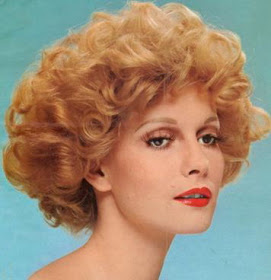
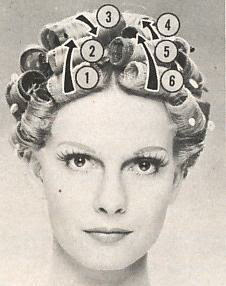
The brick pattern applies mostly to the back; the setting for the front uses triangular sections and pivots around the crown. This technique for setting the front is beautiful but is advanced and hard to do. Allow yourself plenty of time if you try it.
Once you have the pivot around the top, you can set the rest, starting with a tidy ring of rollers around the ones you have set, then work back row by row. It gets harder as you approach the back, especially if your wig doesn't have a lot of hair, but it is also less critical in the back. You can comb this out in many different ways. To get the style shown in the picture, you want to comb upwards and use a fair amount of backcombing.
Pattern Number 4, "Random"

This is from the book Over 200 New Hair Setting Patterns, published in 1969. It is just random rollers, which is easy. It's a great style for "mussed up" waves or curls. Use small rollers for curls (as in the photo) and larger ones for waves. Don't set them in any particular order, but make sure all the hair is in curlers. Try to keep the curlers all the same size or close to it.
Another variation
Here's a variation on one of the earlier patterns from the magazine Set'n Style, Winter 1982. Notice how the two angles on the forehead add some curl to the part. I think this looks great, but I prefer more of a "glam" look. Still very interesting to study:
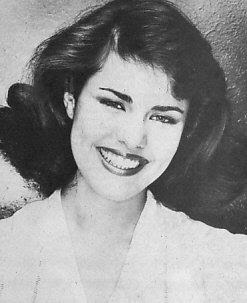
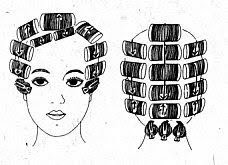
That's it for now!
I hope you have some fun and success with this. If there's enough interest, I will write more as I make more discoveries and find more styling mags.Thanks for reading, and if you have something nice to say or a good idea or suggestion, feel free to write me anytime! I always love hearing from you!